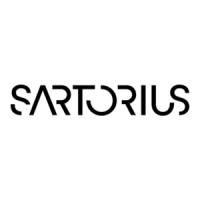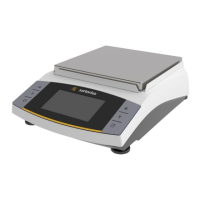28 Entris
®
BCE Operating Instructions
Operation
Requirements
− The automatic or manual start of the isoCal function is set
in the menu (see Chapter “7.2.1 Switching the isoCAL
Function On or Off (Only Model i-1x)”, page 17).
− The device is not located in the menu settings.
− The load on the weighing pan remains unchanged for
2 minutes.
− The load on the scales amounts to no more than 2% of the
maximum load.
− The device does not register an input for 2 minutes.
Procedure
t If the automatic start of the isoCAL function is triggered:
y The [isoCAL] button flashes in the operating display.
y The operating display shows “CAL.” for 19 seconds.
y If no load change or no operation takes place on the
device before the expiration of the time display:
The isoCAL function starts.
t If the manual start of the isoCAL function is triggered:
y The [isoCAL] button flashes in the operating display.
t Press the [isoCAL] button.
y The isoCAL function starts.
8.6 Calibrating and Adjusting the Device
Internally (Only Model i-1x)
Requirements
− The weighing pan is unloaded.
− The operating display shows a stable weight value.
− The internal calibration and adjustment function is set
(see Chapter “7.2.2 Setting Internal Calibration and
Adjustment (Only Model i-1x)”, page 17).
Procedure
t Press the [Zero] button.
t Press the [Adjust] button.
y The weight value is displayed.
t If the calibration function with subsequent automatic
adjustment is selected:
y The “CAL.RUN.” display appears in the operating display
during the process.
y The “CAL.END” display indicates the end of calibration.
t If the calibration function without subsequent automatic
adjustment is selected:
t Press the [Confirm] button.
y The calibration process starts.
y The “CAL.RUN.” display appears in the operating display
during the process.
y The calibration error is displayed.
t Press the [Confirm] button.
y The adjustment is performed.
y The “CAL.END” display indicates the end of calibration.
8.7 Externally Calibrating and Adjusting the
Device
Material Calibration and adjustment weight
Requirements
− The weighing pan is unloaded.
− The operating display shows a stable weight value.
− The external calibration and adjustment function is set
(see Chapter 7.2.3, page 17).
− The preset weight value for the adjustment weight or the
user-defined weight value for the adjustment weight is
selected (see Chapter 7.2.3, page 17).
Procedure
t Press the [Zero] button.
t Press the [Adjust] button.
t Place the indicated calibration and adjustment weight on
the balance.
y The weight value is displayed.
t If the calibration with subsequent automatic adjustment
function is selected and the calibration weight placed on
the device is within the specified limits:
y The adjustment process starts.
y If the “+” prefix was displayed: The applied weight is
too big.
y If the “-” prefix was displayed: The applied weight is
too small.
y The “CAL.END” message indicates the end of calibration.
t Remove the calibration weight.
t If the calibration without subsequent automatic adjustment
function is selected and the calibration weight placed on
the device is within the specified limits:
t Press the [Confirm] button.
y The adjustment process starts.
y If the “+” prefix was displayed: The applied weight is
too big.
y If the “-” prefix was displayed: The applied weight is
too small.
y The “CAL.END” message indicates the end of calibration.
t Remove the calibration weight.
8.8 Printing Results of the Calibration and
Adjustment Process
The results of the calibration and adjustment process can be
printed in a GLP printout.
Procedure
t Set the GLP printout in the menu (setting parameters,
see Chapter 7.3.7, page 22).
t Calibrate the device.
y Once the calibration is complete: The printing process starts.

